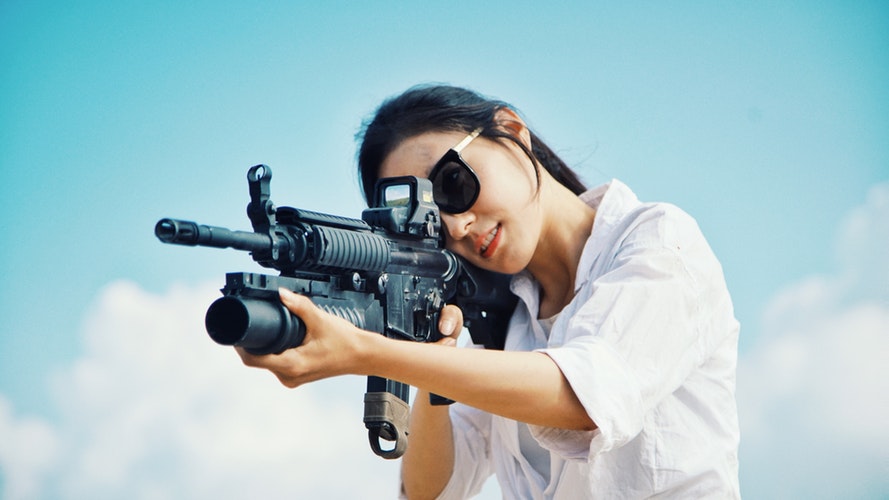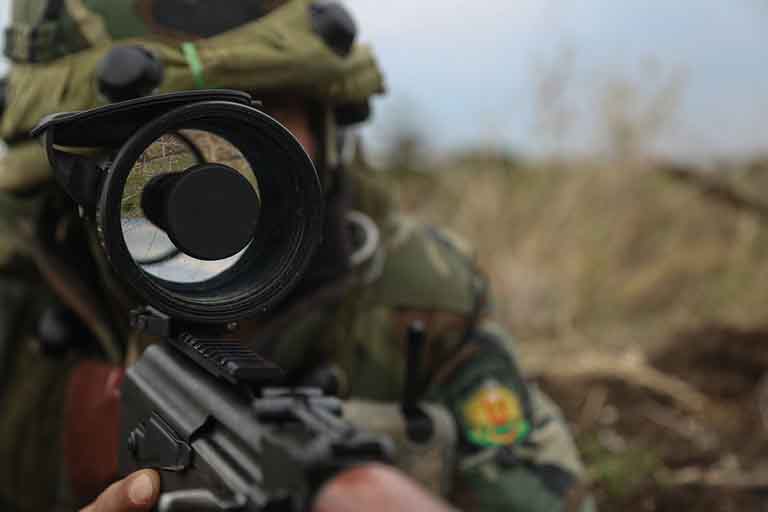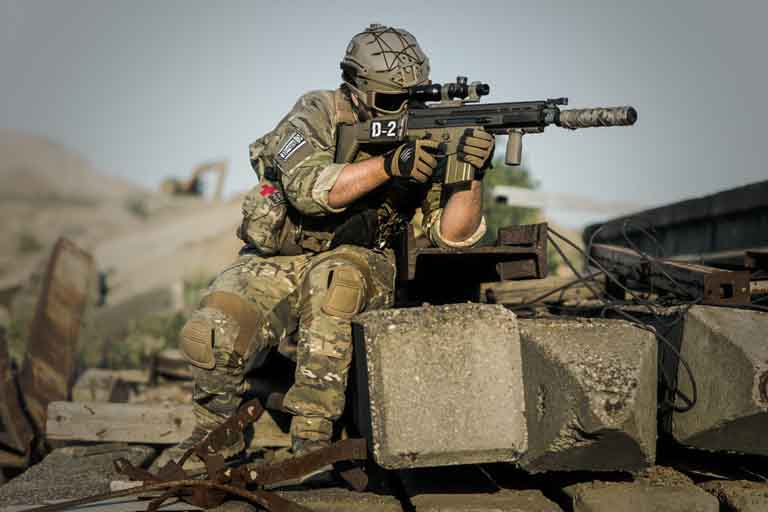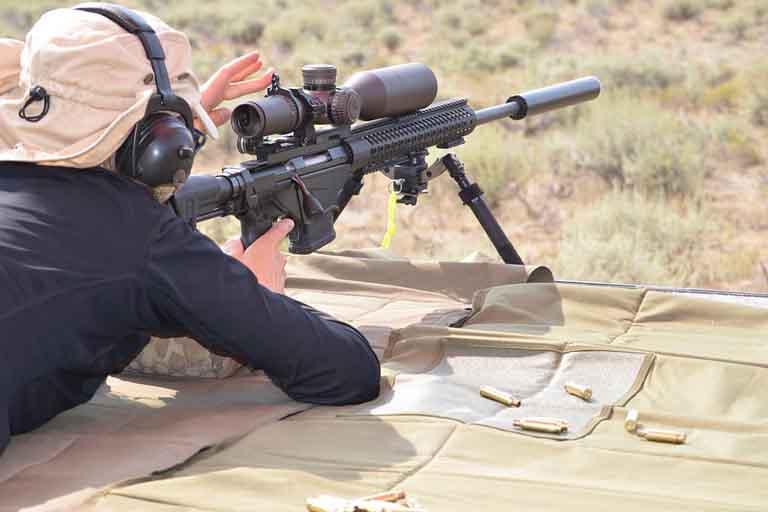
Are you interested in learning how to sight in a red dot scope without shooting? Sighting in a scope is the act of aligning where the scope is pointed with the barrel of the gun. The flight or direction of your bullet is dictated by your barrel, and there are no adjustments for a barrel. The reticle in your scope is the traditional crosshairs, so to speak. You need the reticle to be aimed where the bullet will hit, but the reticle cannot control the bullet in any way.
A red dot sight is an optic that uses a red laser as the reticle, and this offers shooters an easy way to learn how to sight their rifles. Learning how to sight in a red dot scope without shooting is easy to do if you take it one step at a time.
Why Do You Need to Sight In Your Rifle Scope?

Image Source: Pixabay
Sometimes we just assume that we should eye our target and the bullet will travel in a straight line from the rifle to the target. Even though our naked eyes can't perceive it, rifle bullets travel in an arc as gravity pulls them downward.
Sighting your rifle ensures the bullet meets the target where the scope is aimed. If your rifle is sighted at 100 yards, the arc of the bullet will meet dead on with the target from 100 yards out. Deciding a good shooting distance for your particular needs will help you decide what distance to sight in your rifle scope.
You may use your rifle for different tasks and types of hunting. If so, you should sight in your scope before every outing. Ammunition choices also play into the sight adjustments, so it is important to re-sight your weapon any time you change ammunition.
Benefits
Sighting in your scope accounts for all these variables and makes accurate shooting possible. It can also help identify problems with your weapon or with your own shooting technique.
Sighting in the scope will also help you determine the greatest distance at which you can accurately shoot based on your skill level and the weapon you are using. Understanding this limitation will also make hunting safer. You must always know where your bullet is traveling.
Finally, sighting your weapon should give you confidence that it will fire accurately. Shooting with a lingering doubt about whether the rifle will properly do its job can take the fun out of any type of shooting.
Why Sight in a Scope without Shooting?

Image Source: Pixabay
By now you understand the importance of sighting your rifle scope, but why would somebody want to sight the scope without shooting? Some folks sight without shooting in order to ensure safety when they are not at a proper range. Remember, you must always think about your target but also the area behind your target.
A more practical reason is that some thrifty shooters do not want to waste ammunition on sighting. You may have your own reasons for wanting to sight in your rifle scope without shooting, but this process, also known as bore sighting, is a quick and easy method to adjust your sight so it is aligned with the barrel of your rifle.
How to Sight In a Red Dot Scope Without Shooting

Image Source: Pexels
You may be learning how to sight in a red dot scope without shooting because you are a new to red dot scopes or shooting in general. Others may be reviewing how to sight in a red dot scope without shooting because you've acquired a new rifle or recently changed scopes. Either way, here's what to do:
Loose Installation
Stability
Line It Up
Make Adjustments
Tighten It Down
Key Hints and Tips

Image Source: Pexels
Remember, learning how to sight in a red dot scope without shooting comes down to aiming the bullseye. If the rifle is properly sighted, you can hit almost any target. Within the unit, an LED light shines onto a specially designed piece of glass and is reflected to create the reticle.
Lenses
A scope has two primary lenses: the ocular lens and the objective lense. The ocular lens is the one closest to your eye, and the objective lens is the on the target end of the scope.
The objective lense is actually the more critical piece of glass. A large objective lens allows more light into your scope. This is important because magnification will naturally make your scope dim.
A large lense doesn't increase magnification, but it is needed with increased magnification to allow proper light.
Brightness can also be affected by coating your lens. A good lense coating can also provide clarity by manipulating light spectrums. A coated lens is one with a layer of coating on the objective lens. Others will be labeled as a fully coated lens, meaning all lenses are coated.
Multi-coated lens have multiple coats applied to the objective lens, and fully multi-coated lens all lenses are coated with multiple coats.
Magnification

Image Source: Pixabay
Every scope magnifies, and you have to understand how much magnification you prefer. As you learn how to adjust a rifle scope, remember that your scope will only be accurate at the magnification you chose when sighting your scope.
Changing magnifications after sighting the scope will leave it unreliable, so be sure you know what magnification you want. Biggest is not always best.
Remember, a more magnified scope will be less bright, and even the military rarely uses more than 10x power magnification. It does no good to choose a high magnification if you do not have an objective lens with the size and coating needed to provide appropriate light.
Field of View
Your field of view is basically a ratio of feet to yards that measures the width of your scope view at a particular distance. In other words, a field view of 10' at 150 yards means that, when eying a target 150 yards away, you will be able to view five feet on each side of the centered target.
This also plays into your magnification decision, because the more magnification you use, the less field of view (FOV) you will enjoy. The advantage of a broader field of view is being able to quickly locate your target.
Naturally, your eye will want to fix on a landmark, and when you do simply adjust accordingly until your target is in your sight.
Conclusion
As shooters learn how to sight in a red dot scope without shooting, rifle shooting is being revolutionized. For weekend hunters and competitive shooters alike, red dot sights give you the best potential for success.
They can be sighted more quickly than iron sights or magnified optics. Another distinct advantage is that the reticle is on the same shooting plane as the target.
Parallax is the phenomenon when the reticle appears to move as you eye your target. Red dot sighting dramatically reduced parallax. Understanding how to sight in a red dot scope without shooting is an important step to achieve consistently accurate shots. Sighting in the scope is easy if you understand the right way to do it.
Nothing is more important than your scope because it is most responsible for hitting the target. A well-adjusted scope and some practice can result in precise accuracy that is not possible without a scope or with a scope that has not been adjusted and sighted.
Once you have successfully positioned the laser into the rifle, the next step is to look via the scope and monitor the red dot mark. Rotate the cross-hairs of the scope until you sight the center of the red dot mark. In order to direct and control the cross-hairs, use the dials sited at the four edges of the scope. For instance, spinning the top dial in a clockwise direction will shift the cross-hairs in an upward direction. Similarly, you can utilize the side dials by rotating them either in the clockwise or counter-clockwise direction to move the cross-hairs in the left and right side of the scope. It is a must to sustain the rotation of the dials until the gun is zeroed and you point out the center of the red dot.
Very informative! Thank you.
thank you